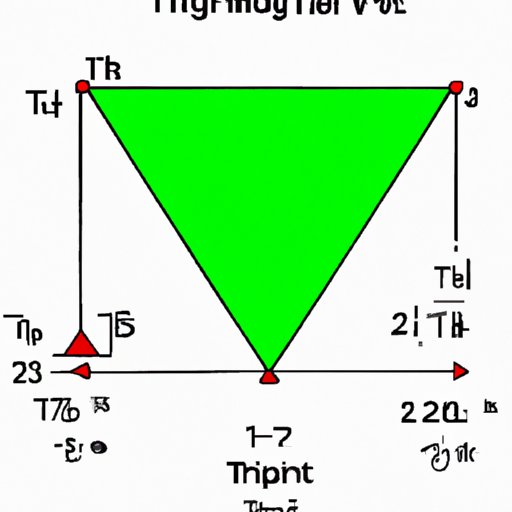
I. Introduction
Knowing how to find the length of a triangle’s sides is an essential mathematical skill that has practical applications in many areas. Whether you’re working in construction, engineering, or architecture, understanding the complexity of triangles can be quite useful. In this article, we will explore how to find the length of a triangle using various mathematical techniques.
II. Understanding the Basics
The Pythagorean Theorem is one of the most basic concepts in geometry and can be used to find the length of a right triangle’s sides. This theorem states that the square of the hypotenuse (the longest side) is equal to the sum of the squares of the other two sides. For example, if you have a right triangle with sides of 3 and 4, you can use the Pythagorean Theorem to find the hypotenuse: 3^2 + 4^2 = 5^2, so the hypotenuse equals 5.
III. Trigonometric Functions
Trigonometric functions – sine, cosine, and tangent – can be used to find the length of a triangle’s sides. These functions are based on the ratios of the sides of a right triangle and can be written as follows:
- sin(A) = opposite/hypotenuse
- cos(A) = adjacent/hypotenuse
- tan(A) = opposite/adjacent
To find the length of a side, you need to know the measure of an angle and the length of another side. For example, if you have a right triangle with an angle of 30 degrees and a hypotenuse of 10, you can use the sine function to find the length of the opposite side: sin(30) = opposite/10, so the opposite side equals 5.
IV. Using the Law of Cosines
The Law of Cosines is a formula that can be utilized to find the length of any side of a triangle. This formula states that:
c^2 = a^2 + b^2 – 2ab cos(C)
where c is the length of the side opposite angle C, and a and b are the lengths of the other two sides. This formula can be particularly useful when you don’t have a right triangle, as the Pythagorean Theorem and trigonometric functions will not work. For example, if you have a triangle with sides of 3, 5, and 7, you can use the Law of Cosines to find the length of the side opposite the 7: 7^2 = 3^2 + 5^2 – 2(3)(5)cos(C). Solving for cos(C) gives you cos(C) = -1/2, which means that angle C is 120 degrees. Finally, you can use the Law of Cosines again to find the length of the side opposite angle C.
V. Heron’s Formula
Heron’s formula is another way to calculate the length of a triangle’s sides, but it’s based on the triangle’s area rather than its angles or sides. This formula states that:
Area = √(s(s-a)(s-b)(s-c))
where s is the semiperimeter of the triangle (half of the perimeter) and a, b, and c are the lengths of the sides. Once you know the area using this formula, you can then use it to find any side length by rearranging the formula. For example, if you have a triangle with sides of 3, 4, and 5, the semiperimeter would be (3+4+5)/2 = 6, and the area would be √(6(6-3)(6-4)(6-5)) = 6. Finally, you can use the area to find the length of any side by rearranging the formula as follows:
- a = 2(Area/b)
- b = 2(Area/a)
- c = 2(Area/c)
VI. Equilateral Triangle Properties
Equilateral triangles have the same length for all sides, which makes them useful when finding the length of other types of triangles. For example, if you have a triangle with sides of 10, 12, and 14, you can draw an altitude from the vertex opposite the longest side to the longest side. This will create two right triangles, both of which will have one leg equal to half the length of the longest side and the other leg equal to the same altitude as the original triangle. From there, you can use the Pythagorean Theorem or trigonometric functions to find the length of the other sides.
VII. Graphical Methods
Graph paper or a graphing calculator can be used to determine the length of a triangle’s sides. To do this, you would first graph the triangle and mark its measurements. Then, you would use the Pythagorean Theorem or trigonometric functions to calculate the unknown lengths. This method can be useful if you’re having trouble visualizing the triangle or working with the formulas.
VIII. Practical Applications
Knowing how to find the length of a triangle is essential when it comes to real-world applications, such as construction or surveying. For example, in construction, you might need to calculate the length of a roof beam or the angle of a roof’s slope. In surveying, you might need to calculate the distance between two points or the height of a structure. Regardless of the application, having a solid understanding of how to find the length of a triangle’s sides can make your work easier and more accurate.
Conclusion
Whether you’re a student studying geometry or a professional working in a technical field, knowing how to find the length of a triangle’s sides is a valuable skill. From the basic Pythagorean Theorem to more advanced techniques like the Law of Cosines and Heron’s formula, there are many ways to approach this problem. By taking the time to learn these different methods, you can tackle any triangle and complete your work more efficiently and accurately.





